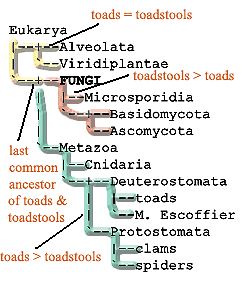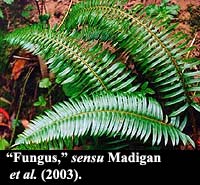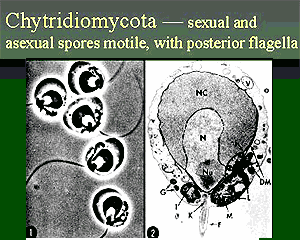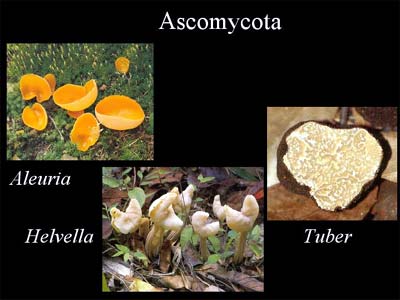The Fungi
What are the Fungi?
 The
Fungi are the great saprophytes, the master recyclers. They are the black
rot, the dry rot, and the white rot, the colorful fate of last week's lasagna
left too long in the 'fridge, and the great, grey walls of stinking mould that can
destroy whole buildings. But, they are also the baker's yeast and
the brewer's yeast. They are the difference between grape juice and
Chateauneuf du Pape. They are the portobellos and the morels and the cloud
ears and the truffles. In fact, the French could not be half so obnoxious
about their cuisine were it not for the Fungi. But, then again, perhaps they
could [1].
The
Fungi are the great saprophytes, the master recyclers. They are the black
rot, the dry rot, and the white rot, the colorful fate of last week's lasagna
left too long in the 'fridge, and the great, grey walls of stinking mould that can
destroy whole buildings. But, they are also the baker's yeast and
the brewer's yeast. They are the difference between grape juice and
Chateauneuf du Pape. They are the portobellos and the morels and the cloud
ears and the truffles. In fact, the French could not be half so obnoxious
about their cuisine were it not for the Fungi. But, then again, perhaps they
could [1].
We leave that conundrum for another day. The first
order of business ought to be the matter of definition. How do we define this
group? We have found no hint that anyone is using a workable phylogenetic
definition of the Fungi. A phylogenetic definition, for those who have
somehow managed to escape our interminable, high-pitched whining on the subject, is a
definition based on some explicit hypothesis about a group's relative position
in phylospace. For example, dinosauria
is defined as the last common ancestor of Triceratops
and birds and all
descendants of that ancestor. This may be conveniently abbreviated: "Triceratops +
birds". Such a definition is quite different from a definition based
on some arbitrary set of characteristics which approximate an implicit,
unstated, and therefore untestable notion of what a dinosaur "ought"
to look like. That second type of definition is referred to as an
"apomorphy-based" definition. It is properly viewed with the same
derisive contempt with which M. Auguste Escoffier (at right) would regard the use of corn starch
to thicken a demi-glace [3].
 Were we in a position to impose
a phylogenetic definition on the
Fungi, our leading candidate would be the stem group "toadstools
> toads" (all organisms more closely related to Basidiomycota than
to Tetrapoda [2]).
That definition presupposes a close relationship between Metazoa
and Fungi. However, such an assumption shouldn't slow us up much. The Metazoa-Fungi
connection now seems quite secure. This definition would, however,
require us to gather the Microsporidia
into the brotherhood of the Fungi. Microsporidia could be Fungi under
many
definition of the taxon, but they are certainly closer to Fungi than to
toads. Such a definition would also dispense with meaningless arguments
about the inclusion of the Chytridiomycota within Fungi.
Were we in a position to impose
a phylogenetic definition on the
Fungi, our leading candidate would be the stem group "toadstools
> toads" (all organisms more closely related to Basidiomycota than
to Tetrapoda [2]).
That definition presupposes a close relationship between Metazoa
and Fungi. However, such an assumption shouldn't slow us up much. The Metazoa-Fungi
connection now seems quite secure. This definition would, however,
require us to gather the Microsporidia
into the brotherhood of the Fungi. Microsporidia could be Fungi under
many
definition of the taxon, but they are certainly closer to Fungi than to
toads. Such a definition would also dispense with meaningless arguments
about the inclusion of the Chytridiomycota within Fungi.
To our discredit, the foregoing discussion may serve as a
useful study in the use of the English conditional mode for advanced students of the
language, but it ignores the realities of fungal phylogeny. That reality
is illustrated in the following examples.
 The
"fungi contain cell walls and produce spores." Madigan
et al. (2003). So ferns are Fungi?
The
"fungi contain cell walls and produce spores." Madigan
et al. (2003). So ferns are Fungi?
The Tree of Life will not venture
even this far. It contents
itself with a list of common names: "The organisms of the fungal
lineage include mushrooms, rusts, smuts, puffballs, truffles, morels, molds, and
yeasts, as well as many less well-known organisms." In other words,
the fungi are defined by listing a number of vague, vernacular terms with a
completely indefinite catch-all category at the end.
"What is Fungi? Fungi are a group of organisms and
micro-organisms that are classified within their own kingdom, the fungal
kingdom, as they are neither plant nor animal. Fungi draw their nutrition from
decaying organic matter, living plants and even animals. They do not
photosynthesize as they totally lack the green pigment chlorophyll, present in
green plants. Many play an important role in the natural cycle as decomposers
and return nutrients to the soil, they are not all destructive." WHAT
IS FUNGI? But this description would apply equally as well to most
bacteria.
 "These
nonmotile eukaryotes lack flagella and develop from spores." Dr. Fungus- Fungi, Fungus,
Fungal. But see the image.
"These
nonmotile eukaryotes lack flagella and develop from spores." Dr. Fungus- Fungi, Fungus,
Fungal. But see the image.
We could beat this drum for quite a long time. The
point is that, of the hundreds of references and sites on the web which purport
to discuss the Fungi, not one of the many we have reviewed supplies a reasonable
definition. Some sources are very useful in listing numerous characteristics of
Fungi. But, the more characters listed, the more Fungi (in any
phylogenetic sense) they exclude. A substantial majority of sources simply
dodge the issue.
Ultimately, we are left in the untenable position of
admitting that there is no definition in general use for the word
"fungus." Happily, this yawning gap at the threshold of mycology
seems to bother mycologists even less than it bothers the Fungi
themselves. Thus, in a manner sanctioned by the universal practice of man
and mushroom alike, we will pointedly ignore the yawning abyss at our feet, and
move on to other matters.
ATW041112. Text public domain. No rights
reserved.
We never eat bread cookies
For cookies have yeast,
And one little bite
Turns a man to a beast
O, can you imagine
A sadder disgrace
Than a man in the gutter
With crumbs on his face?
-- Song of the Salvation Army (trad.)
So, what about all those characteristics mentioned in the last section?
The following is a list of the most commonly cited characters shared by most
Fungi:
- The Fungi are eukayotes, which may
exist in nature as either single and multi-celled organisms, or in both at
different points in the the life cycle.
- Fungi are avascular -- no specialized respiratory, digestive or transport
systems beyond the hyphae themselves.
- Most fungi grow as tubular filaments called hyphae.
A connected mass of hyphae is a mycelium.
- Fungi have a vegetative body called a thallus, composed of
hyphae.
- The walls of hyphae are often reinforced with chitin,
a polymer of N-acetylglucosamine.
- Fungal cell membranes contain ergosterol,
rather than cholesterol.
- The Fungi have a unique biosynthetic pathway for lysine.
- Fungi produce a unique form of tubulin in connection with nuclear
division.
- Fungi have small nuclei with very little repetitive DNA
- Mitosis occcurs without dissolution of the nuclear membrane.
- Fungi are never autotrophs.
No fungus has chlorophyll or chloroplasts.
- Fungi are usually found either as opportunistic saprophytes
(living on dead organic matter) or in some parasitic or symbiotic
relationship with plants or other autotroph.
- Fungi digest food outside their bodies: they release enzymes into the
surrounding environment (exoenzymes), breaking down organic matter into a form the fungus
can absorb
- food reserves stores as glycogen (like animals), not starch (like
plants).
- Fungi reproduce by means of spores,
budding,
or fragmentation.
- Spores may be either sexual or aesexual.
- Spores may be used as a dormant, resting phase, like bacterial spores
In short, Fungi are a rather odd, and distinctly different, part of the tree
of life.
The following is our usual diversity table, which somewhat overemphasizes the
basal Fungi. Recent work suggests that fungal diversity may be
undersampled even at the highest taxonomic levels. Specifically, a
taxonomic survey of alpine fungal communities which flourished under snow cover
suggests that there may be 1-2 high-level fungal taxa between Basidiomycota and Ascomycota. Schadt et
al. (2003).
Fungi
|
| |
 The chytridomycotes, or "chytrids," are usually aquatic, either marine or
freshwater. Presumably this is the original domain of
the chytrids, and of all Fungi, but chytrids are also found in
terrestrial communities almost as soon as there were
terrestrial communities to be found in. So, for example,
several different groups of chytrids are known from the Early
Devonian Rhynie
Chert. The implication is that they had begun to radiate
even before the Devonian. They are a remarkably diverse lot, as
one might expect from a basal radiation of the Fungi, and there
is some possibility that the Chytridomycota may be paraphyletic, i.e.
that all Fungi are descended from chytrids.
The chytridomycotes, or "chytrids," are usually aquatic, either marine or
freshwater. Presumably this is the original domain of
the chytrids, and of all Fungi, but chytrids are also found in
terrestrial communities almost as soon as there were
terrestrial communities to be found in. So, for example,
several different groups of chytrids are known from the Early
Devonian Rhynie
Chert. The implication is that they had begun to radiate
even before the Devonian. They are a remarkably diverse lot, as
one might expect from a basal radiation of the Fungi, and there
is some possibility that the Chytridomycota may be paraphyletic, i.e.
that all Fungi are descended from chytrids.
The chytrids are mostly
single-celled forms, traditionally classified as protists.
In fact, some sources still classify them with the
Chromista, even though, so far as we can tell, chytrids have no
light-sensitive pigments at all. What chytrids do have
is a single- celled zoospore
with an anterior flagellum, which is
distinctly odd for a
fungus. In fact, chytrids are the only large taxon of Fungi
which produces a zoospore of any kind.
However, there's no real doubt about their
position any more. For example Borneman
& Hartin (2000) showed that rDNA primers from all of
four basic fungal phyla (Trichomycota was not included) permit
amplification of rDNA in the other fungal groups, including
Chytridomycota, but don't amplify anything else. This
strongly suggests that that rDNA from all four groups was very
similar and that all are closely related.
That same conclusion can be reached for any number of other
reasons. Chytrids have an absorptive mode of nutrition,
like other Fungi. Chytrids have cell walls composed
of chitin.
Chytrids form hyphae.
They share, with the other Fungi, key enzymes and metabolic pathways that are not found in
other fungus-like protozoans (slime molds and water molds), in
addition to oddities of molecular structure. Alkemar
& Nygard (2003). The chytrids are surely the most basal Fungi, but
Fungi they are.
Image Credit: The
Microbial World.
ATW041115. Text public domain. No rights
reserved.
|
|
Unnamed
Clade
|
This group is sometimes referred to as
Zygomycota, with Zygomycetes and Trichomycetes treated as
included taxa.
|
|
 Zygomycotes, like
chytrids,
are known from the Rhynie
Chert, although, in this case, the identification is more
tentative. What are actually seen are fungal hyphae which
appear to pierce other cells, a characteristic of many
zygomycotes. Definitive zygomycotes are found in
Carboniferous exposures. A more familiar present-day example of a
zygomycote is Rhizopus, the black bread mold. Zygomycotes, like
chytrids,
are known from the Rhynie
Chert, although, in this case, the identification is more
tentative. What are actually seen are fungal hyphae which
appear to pierce other cells, a characteristic of many
zygomycotes. Definitive zygomycotes are found in
Carboniferous exposures. A more familiar present-day example of a
zygomycote is Rhizopus, the black bread mold.
The Zygomycota are named for their
characteristic teleomorph,
which is referred to as a zygosporangium.
The images at the glossary entry for gametangium
are of Phycomyces and Rhizopus, both
zygomycotes. They illustrate how the zygosporangium is
formed from the head-on meeting of two hyphae
whose ends have specialized as gametangia. The contents of
the gametangia are mixed in the zygosporangium, which develops
between them. The haploid nuclei from the gametangia then
fuse. The zygosporangium develops a hard, thick chitin
shell, which is frequently ornamented and may bear spines or
other appendages. The remains of the gametangia protrude
from the sides and are referred to as suspensors.
The zygosporangium also serves as a resting phase, which will
develop when conditions are favorable.
Zygomycotes also reproduce asexually.
The haploid spores develop in a bulbous mitosporangium
at the tips of specialized vertical hyphae referred to as sporangiophores.
Image: Dr.
Paul Davis, Univ. N. Alabama.
ATW041116. Text public domain. No rights
reserved.
|
|
|
From time to time we find a web
resource that is so comprehensive well-organized that there is
no point in providing a summary here. That is the case
with the Trichomycota. We happily defer to The
Trichomycetes: Fungal Associates of Arthropods.
The authors' own summary of their work is Chapter 1 of the
treatise. Trichomycotes are obligate commensals
(sometimes parasites) of insects and are thought to have
developed with neopteran insects in the Mississippian.
|
|
 The basidiomycotes are the
rusts, smuts, gilled mushrooms, puffballs, stinkhorns,
and club, shelf or coral fungi. They are one of the two
major divisions of Fungi, the other being the Ascomycota. Definitive Basidiomycote fossils are
known from the Late
Devonian, although there has been a recent report of a
possible Early
Devonian lichen incorporating a probable basidiomycote
fungus. The basidiomycotes are the
rusts, smuts, gilled mushrooms, puffballs, stinkhorns,
and club, shelf or coral fungi. They are one of the two
major divisions of Fungi, the other being the Ascomycota. Definitive Basidiomycote fossils are
known from the Late
Devonian, although there has been a recent report of a
possible Early
Devonian lichen incorporating a probable basidiomycote
fungus.
The Basidiomycota is such a large and diverse group, that the
living members have little in common. The basidiomycote
life cycle has a four unique properties which are probably
synapomorphies, but which are no longer shared by all members of
the group:
(1) The taxon is named for the basidium
where sexual spores are produced.
(2) The life cycle generally includes a persistent dikaryon,
frequntly large (e.g., a mushroom) in which each cell in the thallus
contains two haploid nuclei, typically as the resulting of
a mating event
(3) Clamp
connections (explained at the glossary entry) are unique
to Basidiomycota and are used to maintain the dikaryon state
during hyphal
division.
(4) Many basidiomycotes can launch spores into the air
in a process referred to as ballistospory.
The basidiospores
bear a single haploid nucleus. They germinate into hyphae
with a single nucleus in each compartment, a monokaryon.
A mating event results from end-to-end fusion of hyphae, as in
Zygomycota, or fusion of a hypha with an oidium,
a specialized mating spore. Then the resulting dikaryon
divides through clamp connections so that the dikaryon state is
maintained. Many basidiomycotes remain in the dikaryon
state indefinitely. Under appropriate conditions, the
dikaryon will produce fruiting
bodies. Some of these hyphae produce basidia,
such as the cells lining the "gills" under the cap of
gilled mushrooms. Ultimately, the two haploid nuclei
in each basidium fuse (karyogamy)
to form a diploid nucleus. This then undergoes meiosis to
produce four haploid nuclei whch migrate into the basidiospores
and are dispersed into the environment.
ATW041116. Text public domain. No rights
reserved.
|
|
 The Ascomycota are the
largest and most diverse group of Fungi. They include the
yeasts, most of the fungal elements of lichen, and such famous
Fungi as Saccharomyces, Aspergillus, Candida and Neurospora,
as well as morels, truffles and similar delicacies. The
current understanding is that supposed pre-Devonian
(even Proterozoic!)
lichens are probably artifacts, making the earliest known
ascomycote of Carboniferous
age. The Ascomycota are the
largest and most diverse group of Fungi. They include the
yeasts, most of the fungal elements of lichen, and such famous
Fungi as Saccharomyces, Aspergillus, Candida and Neurospora,
as well as morels, truffles and similar delicacies. The
current understanding is that supposed pre-Devonian
(even Proterozoic!)
lichens are probably artifacts, making the earliest known
ascomycote of Carboniferous
age.
The Ascomycota are united by the presence of asci
(see glossary entry). Like Basidiomycota,
ascomycotes remain indefinitely in the dikaryon
state, with the fungal filaments (hyphae)
partitioned into cells each containing two haploid nuclei -- one
from each parent. Also as in basidiomycotes, nuclear
fusion (karyogamy)
occurs only in connection with the formation of sexual
spores. At that time the newly diploid nucleus undergoes
one (sometimes more) round of mitosis, followed by meiosis,
to yield eight (or a multiple of eight) haploid nuclei. The
nuclei are then partitioned by internal membranes into
individual ascospores.
The Ascomycota also share with Basidiomycota the use of conidia
for the development of asexual spores. Another unique
character (but not present in all ascomycotes) is the presence of Woronin
bodies on each side of the septa separating the hyphal
segments. The septae are pierced by pores which allow most
cytoplasmic constituents (but not nuclei) to travel freely
between hyphae. However, if an adjoining hypha is
ruptured, the Woronin bodies block the pore to prevent loss of
cytoplasm into the ruptured compartment. For
more information, see Ascomycota. ATW041118.
Text public domain. No rights reserved. |
|
images not loading? | error messages? | broken links? | suggestions? | criticism?
page revised MAK120115. All content by ATW public domain.


 The
Fungi are the great saprophytes, the master recyclers. They are the black
rot, the dry rot, and the white rot, the colorful fate of last week's lasagna
left too long in the 'fridge, and the great, grey walls of stinking mould that can
destroy whole buildings. But, they are also the baker's yeast and
the brewer's yeast. They are the difference between grape juice and
Chateauneuf du Pape. They are the portobellos and the morels and the cloud
ears and the truffles. In fact, the French could not be half so obnoxious
about their cuisine were it not for the Fungi. But, then again, perhaps they
could [1].
The
Fungi are the great saprophytes, the master recyclers. They are the black
rot, the dry rot, and the white rot, the colorful fate of last week's lasagna
left too long in the 'fridge, and the great, grey walls of stinking mould that can
destroy whole buildings. But, they are also the baker's yeast and
the brewer's yeast. They are the difference between grape juice and
Chateauneuf du Pape. They are the portobellos and the morels and the cloud
ears and the truffles. In fact, the French could not be half so obnoxious
about their cuisine were it not for the Fungi. But, then again, perhaps they
could [1].
 Were we in a position to impose
a phylogenetic definition on the
Fungi, our leading candidate would be the stem group "toadstools
> toads" (all organisms more closely related to Basidiomycota than
to Tetrapoda [2]).
That definition presupposes a close relationship between Metazoa
and Fungi. However, such an assumption shouldn't slow us up much. The Metazoa-Fungi
connection now seems quite secure. This definition would, however,
require us to gather the Microsporidia
into the brotherhood of the Fungi. Microsporidia could be Fungi under
many
definition of the taxon, but they are certainly closer to Fungi than to
toads. Such a definition would also dispense with meaningless arguments
about the inclusion of the Chytridiomycota within Fungi.
Were we in a position to impose
a phylogenetic definition on the
Fungi, our leading candidate would be the stem group "toadstools
> toads" (all organisms more closely related to Basidiomycota than
to Tetrapoda [2]).
That definition presupposes a close relationship between Metazoa
and Fungi. However, such an assumption shouldn't slow us up much. The Metazoa-Fungi
connection now seems quite secure. This definition would, however,
require us to gather the Microsporidia
into the brotherhood of the Fungi. Microsporidia could be Fungi under
many
definition of the taxon, but they are certainly closer to Fungi than to
toads. Such a definition would also dispense with meaningless arguments
about the inclusion of the Chytridiomycota within Fungi.  The
"fungi contain cell walls and produce spores." Madigan
et al. (2003). So ferns are Fungi?
The
"fungi contain cell walls and produce spores." Madigan
et al. (2003). So ferns are Fungi?  "These
nonmotile eukaryotes lack flagella and develop from spores." Dr. Fungus- Fungi, Fungus,
Fungal. But see the image.
"These
nonmotile eukaryotes lack flagella and develop from spores." Dr. Fungus- Fungi, Fungus,
Fungal. But see the image.